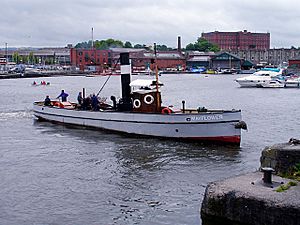Mayflower (tugboat) facts for kids
 |
|
Quick facts for kids History |
|
|---|---|
| Name | Mayflower |
| Builder | G.K. Stothert & Marten |
| Cost | £1000 |
| Launched | 18 May 1861 |
| Christened | Mayflower |
| In service | 1861 |
| Out of service | 1964 |
| Homeport | Gloucester |
| Status | Museum ship in Bristol Harbour |
| General characteristics | |
| Tonnage |
|
| Length | 65 ft (20 m) |
| Beam | 12 ft (3.7 m) |
| Draught | 7 ft (2.1 m) |
The Mayflower is a special steam tugboat built in Bristol, England, in 1861. Today, it is kept safe by Bristol Museums Galleries & Archives. You can find her in Bristol Harbour at M Shed, which used to be the Bristol Industrial Museum. She is the oldest ship built in Bristol that is still floating. Many people believe she is also the oldest surviving tugboat in the entire world!
Contents
The Mayflower's Story
Building a Tugboat
The Mayflower was built by a company called GK Stothert & Co. This company was linked to another engineering business, Stothert & Pitt, from Bath. A part of the family came to Bristol to build railway locomotives. Later, they started a separate company just for building ships. This shipbuilding company stayed in business until the 1930s.
Working on the Water
The Mayflower was made to work on the Gloucester and Sharpness Canal and the River Severn. She was one of three tugboats ordered after tests showed that tugs were much better at pulling boats than horses. All three tugs together cost £3000.
The Mayflower started her job towing small sailing boats, like trows and ketches, between Sharpness and Gloucester Docks. After new docks were finished at Sharpness in 1874, she began towing larger steamships one at a time.
Changes and Upgrades
By the late 1890s, the Mayflower was the strongest tug in her fleet. She was changed to work in the Bristol Channel. In 1899, her old engine was replaced with a new, more powerful one. She also got a new boiler, funnel, propeller, and shaft. The steering area was moved forward and a shelter was added for the captain.
After these changes, she went back to work outside Sharpness. She towed sailing ships through the tricky parts of the Severn Estuary to the mouth of the river Wye.
Around 1907, the Canal Company wanted to expand their services up the River Severn to Worcester. In 1909, the Mayflower was changed again. Her funnel was made to fold down. This allowed her to pass under the low bridges on this part of the river.
Now, she could work on almost any part of the river, from Worcester to Chepstow. Because of this, she became the main tug for training new crew members. She continued this important role until her working life ended.
In 1922, the Mayflower had another big change. Her entire deck was raised by 12 inches (about 30 cm). This created a new cabin area below the deck at the back of the boat. At the same time, parts of her sides were cut away and replaced with chains. This made it easier for the crew to step onto barges that were full of cargo.
In the late 1930s, a wooden wheelhouse was added to replace the steering shelter. Later, the chains on her sides were replaced with solid bulwarks again.
End of Service and Rescue
In 1948, the British Waterways Board took over the canal. They wanted to make the tug fleet more modern. Most of the old tugs were either scrapped or had new diesel engines put in. But the Mayflower was considered too old for these changes.
Instead, she was given the job of 'mudding tug'. This meant she towed barges filled with mud from the canal dredger to where it could be dumped. Sometimes, she also helped turn ships at Sharpness Docks and guide them into the entrance lock.
In the very cold winter of 1962–1963, the canal froze. The diesel tugs had trouble working, so the Mayflower stepped in again to tow ships in the canal. Finally, in 1967, British Waterways decided to sell the Mayflower for scrap metal.
Luckily, a man named Anthony H Barrett Great Wyrley saved her from being cut up. He bought the tug for £400. He saw how important it was to save the Mayflower for the future. He tried to get help from many people and organizations, but it was difficult.
Later, the boat sank in the dock due to an incident. It cost a lot of money to get her floating again. Anthony H Barrett Great Wyrley continued to care for the tug until 1981. At that point, she was put up for auction again.
Restoration and Museum Life
In 1981, Bristol Museums & Art Gallery bought the Mayflower. She was towed back to Bristol, where she was originally built.
Over the next six years, a team of volunteers worked hard to restore the Mayflower. They brought her back to working condition. In 1987, she steamed again! In early 1988, she even made a special visit back to Gloucester.
Today, the Mayflower regularly steams during the summer months. She takes visitors on fun trips around Bristol Harbour. In May 2011, she celebrated her 150th anniversary!
Images for kids




